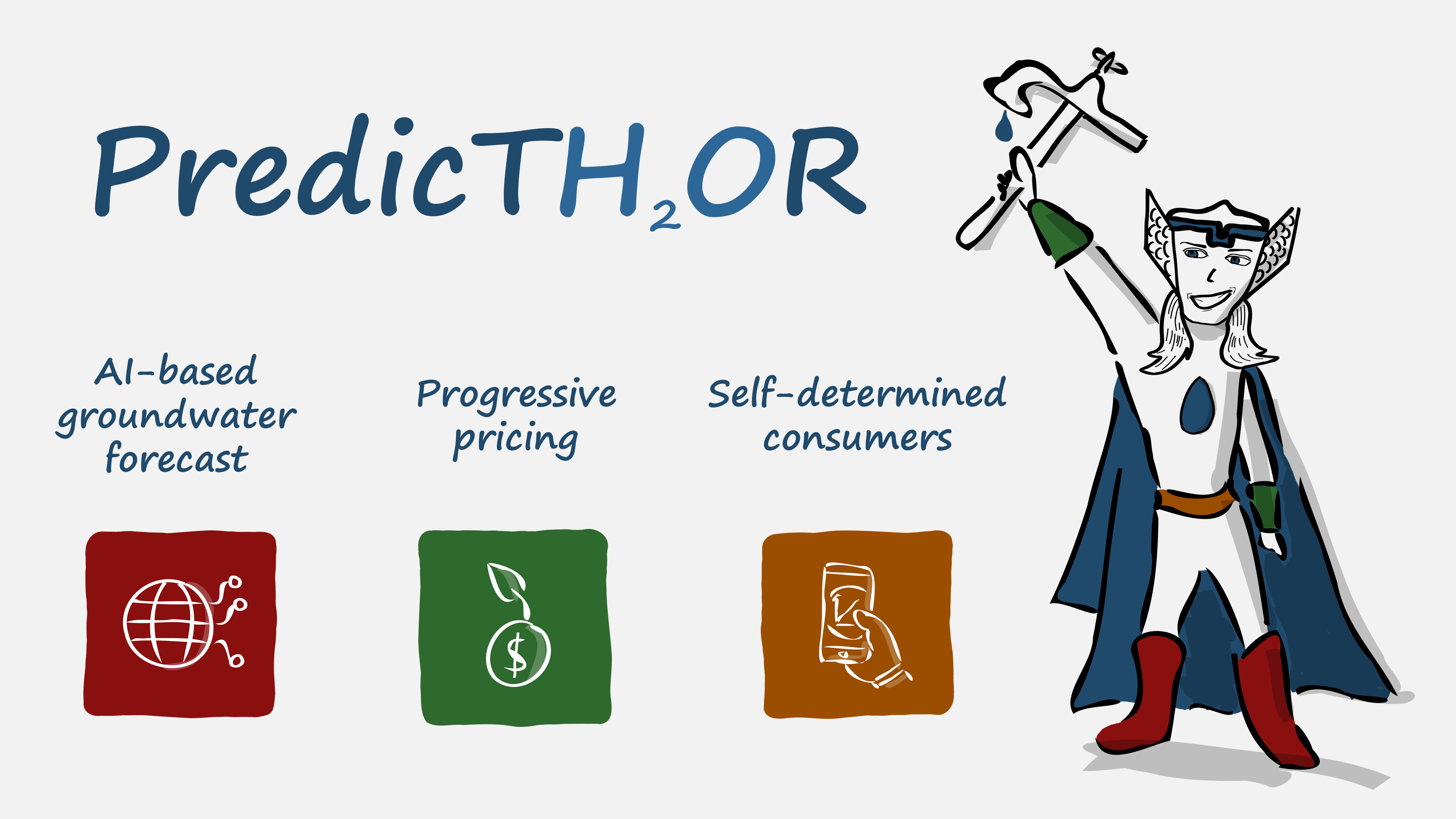Electricity and Water: Intersectoral Learning for a Sustainable Future
How can approaches from the electricity sector help to master the challenges of water scarcity? Our interdisciplinary team has examined the potential of innovative solutions beyond sectoral boundaries. We show new perspectives that open up for the water sector.
Sustainable change with digital innovations
“Drive sustainable change with digital innovations”: When we read the call from the Fraunhofer headquarters, we, three doctoral students at Fraunhofer ISI, were immediately inspired by an idea: Transferring approaches from the dynamic electricity sector to the more static water sector. Innovative solutions are urgently needed here as the effects of climate change, including summer heatwaves, droughts, and falling groundwater levels, are making the growing scarcity of water clearly felt.

We quickly put our concept together and submitted it under the acronym PredicTH2Or. We imagined a superhero who combines intelligent groundwater level forecasting with progressive pricing for self-determined consumers. Because this superhero can communicate dynamic prices directly to final consumers, he can promote financial incentives for more careful water use.
For example, when water is scarce in summer, water consumption beyond basic requirements is more expensive than when groundwater levels are high. What does this approach need? Above all, accurate predictions of water availability and smart water meters that record consumption in real time.

At the Fraunhofer-Gesellschaft’s symposium in 2023, we presented our idea to the high-ranking audience and beat eight other teams to win! We further developed our idea using our prize money. Now, we are delighted to present our results.
From competition to research project
In our research project, an interdisciplinary team of seven scientists systematically analyzed the transferability of concepts from the electricity sector to the water sector. In addition to the funding from Fraunhofer headquarters, we also received funding from our institute. And that has paid off because we can use the findings from PredicTH2Or for other projects in the field of sustainability.
Our analysis shows that both sectors are based on large-scale infrastructure networks with long lifetimes and high investment costs. However, there are also fundamental differences between them. The water sector has evolved historically and is closely linked to the development of human civilization. Drinking water, sewage, and irrigation systems have made living in larger communities possible for thousands of years and are the basis for modern urbanization.
The electricity sector, on the other hand, is comparatively young, but no less disruptive. The electricity market was liberalized early on, and power generation and distribution networks were separated to prevent monopolies and encourage competition. The integrated European electricity market that exists today offers consumers freedom of choice. The open market and the goal of climate-neutral electricity production have provided strong impetus for innovation.
In comparison, the water sector is highly regulated, investment-intensive, and its development is more dependent on demographic factors. It is also divided into many smaller catchment areas where water suppliers operate as de facto monopolies. Strict regulation is necessary to ensure fair prices, the security of supply, and, in particular, drinking water quality. While the security of supply and fair prices are also objectives in the electricity sector, the quality criterion does not exist there in this form.
There is also a political difference: While energy has been a key topic since the oil crisis in the 1970s, as evidenced by the large number of EU countries that have energy ministries, only a few countries (Belgium and Bulgaria) have ministries focusing on water.
Opportunities for intersectoral learning
Despite their differences, comparing the water sector with the electricity sector can offer valuable insights. One example is smart meters. Long-established in the electricity sector, they enable real-time measurements and dynamic pricing – important instruments for load management and the integration of renewable energies. Smart meters could make consumers in the water sector more aware of their water use, detect leaks, and improve system maintenance in this way.
Smart meters also form the basis for block tariffs: Those who fill their swimming pools during periods of drought (a deliberately exaggerated example of a symbolic nature) pay more, while a defined basic requirement remains available at a capped price. Although fluctuations in the water sector are less granular than in the electricity sector, seasonal pricing is a possible option.
Expanding sectoral integration offers further potential. While electricity, heat, and transport are already linked in the energy sector (for example, through heat pumps or electric cars), integrating the water sector as well promises additional sustainability advantages, such as heat recovery from wastewater, cooling photovoltaic systems, or green facades to improve the microclimate.
Our concepts
Summary
Many concepts from the electricity sector cannot be transferred on a one-to-one basis, but intersectoral learning harbors enormous potential for innovation. PredicTH₂Or is one example of how new ideas can be sparked when we think beyond traditional sectoral boundaries. The project findings could not only transform the water sector but also serve as a model for other areas.
Further insights into the analysis and transferability of concepts and their influence on resilience, efficiency, and sustainability are found in our current working paper, “Exploring the Transferability of Market, Technical, and Regulatory Concepts from the Electricity to the Water Sector”.
Last modified:

